
Palma, also known as Palma de Mallorca is the capital and largest city of the autonomous community of the Balearic Islands in Spain. It is situated on the south coast of Mallorca on the Bay of Palma. The Cabrera Archipelago, though widely separated from Palma proper, is administratively considered part of the municipality. As of 2018, Palma Airport serves over 29 million passengers per year.
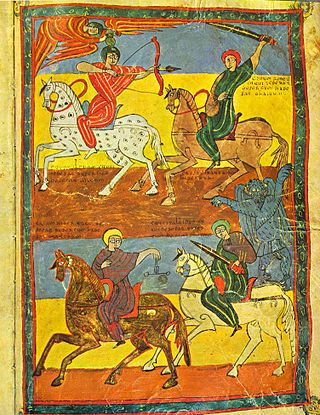
The Mozarabs, or more precisely Andalusi Christians, were the Christians of al-Andalus, or the territories of Iberia under Muslim rule from 711 to 1492. Following the Umayyad conquest of the Visigothic Kingdom in Hispania, the Christian population of much of Iberia came under Muslim control.

An alcázar, from Arabic al-Qasr, is a type of Islamic castle or palace in the Iberian Peninsula built during Muslim rule between the 8th and 15th centuries. They functioned as homes and regional capitals for governmental figures throughout the Umayyad caliphate and later, for Christian rulers following the Spanish Reconquista. The term alcázar is also used for many medieval castles built by Christians on earlier Roman, Visigothic or Islamic fortifications and is frequently used as a synonym for castillo or castle.

Al-Andalus was the Muslim-ruled area of the Iberian Peninsula. The term is used by modern historians for the former Islamic states in modern Spain and Portugal. At its greatest geographical extent, it occupied most of the peninsula and a part of present-day southern France, Septimania. For nearly 100 years, from the 9th century to the 10th, al-Andalus extended its presence from Fraxinetum into the Alps with a series of organized raids. The name describes the different Muslim states that controlled these territories at various times between 711 and 1492. These boundaries changed constantly as the Christian Reconquista progressed, eventually shrinking to the south and finally to the Emirate of Granada.
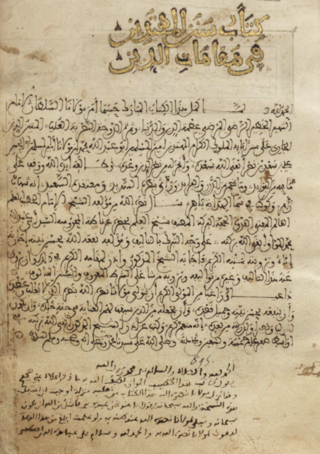
Andalusi Arabic, also known as Andalusian Arabic, was a variety or varieties of Arabic spoken mainly from the 9th to the 17th century in Al-Andalus, the regions of the Iberian Peninsula once under Muslim rule. It became an extinct language in Iberia after the expulsion of the former Hispanic Muslims, which took place over a century after the Granada War by the Catholic Monarchs of Spain. Once widely spoken in Iberia, the expulsions and persecutions of Arabic speakers caused an abrupt end to the language's use on the peninsula. Its use continued to some degree in North Africa after the expulsion, although Andalusi speakers were rapidly assimilated by the Maghrebi communities to which they fled.

The Nasrid dynasty was the last Muslim dynasty in the Iberian Peninsula, ruling the Emirate of Granada from 1230 until 1492. Its members claimed to be of Arab origin. Twenty-three emirs ruled Granada from the founding of the dynasty in 1230 by Muhammad I until 2 January 1492, when Muhammad XII surrendered all lands to Queen Isabella I of Castile. Today, the most visible evidence of the Nasrid dynasty is part of the Alhambra palace complex built under their rule.

The Royal Alcázars of Seville, historically known as al-Qasr al-Muriq and commonly known as the Alcázar of Seville, is a royal palace in Seville, Spain, built for the Christian king Peter of Castile. It was built by Castilian Christians on the site of an Abbadid Muslim alcazar, or residential fortress. The fortress was destroyed after the Christian conquest of Seville in 1248.

Valencian cuisine is a Mediterranean cuisine as cooked in the Valencian Community, Spain. Its basic ingredients are vegetables, seafood and meat. It is famous worldwide for its rices, such as paella, and its citrus fruits. The cuisine of neighbouring regions have given and received important contributions from Valencian gastronomy, amongst them Balearic cuisine, Catalan cuisine, Aragonese cuisine, Manchego cuisine and Murcian cuisine.

The Emirate of Córdoba or Umayyad Emirate of Córdoba was a medieval Islamic kingdom in the Iberian Peninsula.
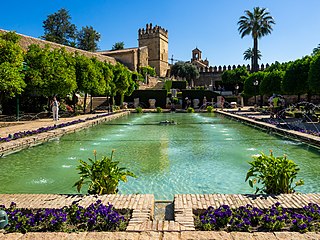
The Alcázar de los Reyes Cristianos, also known as the Alcázar of Córdoba, is a medieval alcázar located in the historic centre of Córdoba, next to the Guadalquivir River and near the Mosque-Cathedral. The fortress served as one of the primary residences of Isabella I of Castile and Ferdinand II of Aragon.

Moorish architecture is a style within Islamic architecture which developed in the western Islamic world, including al-Andalus and what is now Morocco, Algeria, and Tunisia. The term "Moorish" comes from the historical Western European designation of the Muslim inhabitants of these regions as "Moors". Scholarly references on Islamic architecture often refer to this architectural tradition by a more geographic designation, such as architecture of the Islamic West or architecture of the Western Islamic lands, and some references on Islamic art and architecture consider use of the term "Moorish" to be outdated or contested.
Ali ibn Attiya ibn al-Zaqqaq was one of the great poets of Al-Andalus during the reign of the Almoravids. He was a Muslim from Banu Lakhm. His mother was the sister of fellow Andalusian poet, Ibn Khafaja, and there is scholarly dispute regarding his father. He was a disciple under philosopher Ibn Ṣîd de Badajoz.

An alquería in Al-Andalus made reference to small rural communities that were located near cities (medinas). Since the 15th century it makes reference to a farmhouse, with an agricultural farm, found mainly in eastern and southeastern Spain, such as Granada and Valencia. Regarding the latter location Joan Fuster, in his book called El País Valenciano, makes extensive reference to the Valencian alquerías. Vestiges and documents referring to alquerias, known as alcarias in Portuguese, have been found in Portugal's southern region of Algarve. From Central Portugal to the Algarve passing through Alentejo region, a number of places in Portugal have the word Alcaria in its name.

Zayd Abu Zayd was the last Almohad governor of Valencia.
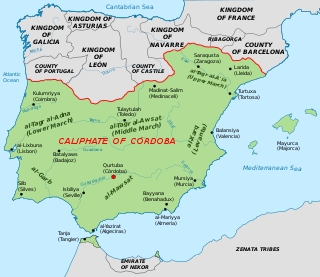
The Caliphate of Córdoba, also known as the Cordoban Caliphate was an Islamic state ruled by the Umayyad dynasty from 929 to 1031. Its territory comprised Iberia and parts of North Africa, with its capital in Córdoba. It succeeded the Emirate of Córdoba upon the self-proclamation of Umayyad emir Abd ar-Rahman III as caliph in January 929. The period was characterized by an expansion of trade and culture, and saw the construction of masterpieces of al-Andalus architecture.
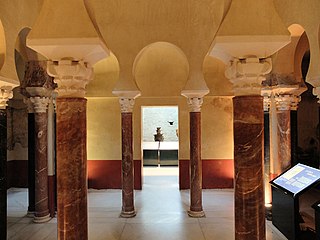
The Caliphal Baths are an Islamic bathhouse complex in Córdoba, Spain. They are situated in the historic centre which was declared a World Heritage Site by UNESCO in 1994. The complex was contiguous to the former Caliphal Palaces of the Umayyads, whose inhabitants it served. Today the baths have been partially reconstructed and are open as a museum.
Lubna of Córdoba was an Andalusian intellectual, mathematician, and poet of the second half of the 10th century known for the quality of her writing and her excellence in the sciences. Lubna was born into slavery and raised within the Madīnat al-Zahrā palace. She then pursued a career within the palace as part of Al-Hakam II's team of copyists.
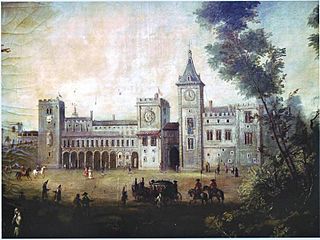
The now vanished Del Real Palace or Royal Palace was the former residence of the kings of Valencia in the «Cap i Casal» of the Kingdom, as the city of Valencia was then called. It was on the left bank of the Turia River, where nowadays Jardines del Real are. It was also known as «300 keys palace» in reference to the number of rooms it had in its heights.

The Alcázar of the Caliphs or Caliphal Alcázar, also known as the Umayyad Alcázar and the Andalusian Alcazar of Cordoba, was a fortress-palace (alcázar) located in Córdoba, in present-day Spain. It was the seat of the government of Al-Andalus and the residence of the emirs and caliphs of Córdoba from the 8th century until the 11th century and the residence of local Muslim governors from the 11th century until the Christian conquest in 1236. The site was composed of heterogeneous constructions ranging from the private residences of the rulers and their households to the government offices and administrative areas. Today, only minor remains of the palace have survived, including the Caliphal Baths which have been converted into a museum. The rest of the site is occupied by later structures including the Alcázar de los Reyes Cristianos, the Episcopal Palace, the Seminary of San Pelagio, and the Campo Santos de los Mártires public square.
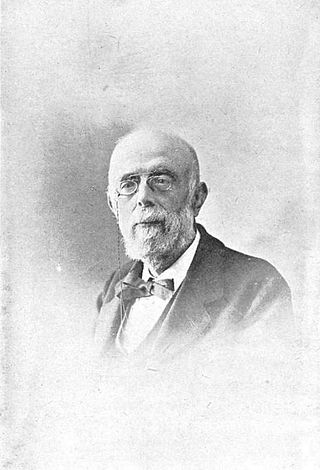
Francisco Codera y Zaidín was a Spanish historian, philologist and Arabist scholar. Among his students, known in the academic field as the Beni Codera, were Arabists Rafael Altamira and José Deleito.



















